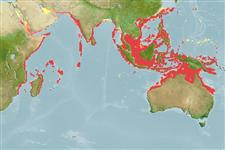Common names from other countries
sub class Elasmobranchii (ฉลามและกระเบน) (sharks and rays) >
Myliobatiformes (Stingrays) >
Myliobatidae (Eagle and manta rays)
Etymology: Aetomylaeus: Greek, aetos = eagle + Greek, mylio = mill, grinder (Ref. 45335).
More on author: Bleeker.
Environment: milieu / climate zone / depth range / distribution range
นิเวศวิทยา
เกี่ยวกับทะเล,น้ำเค็ม กลุ่มสัตว์หน้าดิน,กลุ่มสัตว์พื้นท้องน้ำ; ระดับความลึก 1 - 110 m (Ref. 9862). Tropical; 28°N - 24°S, 32°E - 155°E
Indo-West Pacific: scattered localities, from southern Mozambique to the western Pacific.
Length at first maturity / ขนาด / น้ำหนัก / Age
Maturity: Lm ?, range 170 - ? cm
Max length : 240 cm WD เพศผู้/กระเทย; (Ref. 58048)
Found in muddy bays and banks and on coral reefs from close inshore to 110 m depth (Ref. 9862). Ovoviviparous (Ref. 50449). Caught in bottom trawls, gillnets, seines, and fish traps (Ref. 9862, Ref.58048). Utilized for its meat and cartilage (possibly used as "filler" in shark fin soups as with other large eagle rays) (Ref.58048).
Life cycle and mating behavior
Maturities | การสืบพันธุ์ | Spawnings | Egg(s) | Fecundities | ตัวอ่อน
Exhibit ovoviparity (aplacental viviparity), with embryos feeding initially on yolk, then receiving additional nourishment from the mother by indirect absorption of uterine fluid enriched with mucus, fat or protein through specialised structures (Ref. 50449).
Last, P.R. and J.D. Stevens, 1994. Sharks and rays of Australia. CSIRO, Australia. 513 p. (Ref. 6871)
IUCN Red List Status (Ref. 130435)
CITES (Ref. 128078)
Not Evaluated
Threat to humans
Harmless
Human uses
Warning: mysqli::__construct(): (08004/1040): Too many connections in /var/www/html/includes/func_getlabel.php on line 46
Can't connect to MySQL database (fbapp). Errorcode: Too many connections
